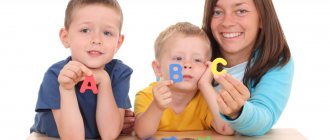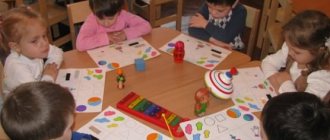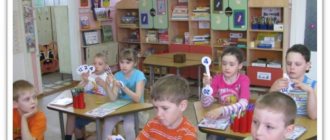The formation and active development of the level of coherent speech for preschoolers requires not only the increased attention of both parents, but also specialized classes that can be conducted in a playful or theatrical form, which is especially attractive to children. In the process of working with children, speech therapists and teachers use many modern techniques, among which mnemonics stands out, aimed at actively developing the level of coherent speech and memory in preschool children.
What is mnemonics
Mnemonics for increasing the level of speech development is a set of techniques aimed at improving perception with memorization of various information using sound samples and visual illustrations.
Provided that classes are carried out systematically, mnemonics for speech development allow you to:
- improve the memorization of heard texts in the form of stories, fairy tales, etc.;
- transform visually acquired data into abstract (and vice versa);
- create logical chains of events;
- Expand words knowledge;
- stimulate the development of imagination and thinking;
- develop children’s ability to compose complex sentences of a descriptive type, which include many words.
Mnemonics, as one of the most effective methods of memorization, is actively used not only by speech therapists, but also by teachers in kindergartens and other preschool institutions.
There are no age restrictions for classes, but many specialized experts recognize the age of 4-5 years as the most optimal, when children already have a fairly rich and varied stock of words and phrases that they can actively use.
The main tool that is used in mnemonics for developing the level of coherent speech in preschool children are mnemonic tables - specific diagrams in which certain information data is embedded.
Mnemonic diagrams for the little ones should be painted in bright shades so that the image that a frog is green, a chicken is yellow, etc. is imprinted in their minds.
For older children, it is preferable to use single-color schemes that do not distract attention, distracting them with additional, and often unnecessary, details.
Using mnemonic techniques in children's speech development
Batagovskaya Natalya Nikolaevna Malyavina Natalya Nikolaevna educators MBDOU DS No. 27 “Beryozka” Starooskolsky urban district
Today, figurative speech, rich in synonyms, additions and descriptions, in preschool children is a very rare phenomenon. This is monosyllabic speech, consisting only of simple sentences, and the inability to form a common sentence grammatically correctly. At the stage of completing preschool education, the child must have good command of oral speech, use speech to express his thoughts, feelings, desires, and highlight sounds in words.
One of the methods for developing children’s coherent speech is “mnemonics.”
Mnemonics is a system of methods and techniques that ensure successful memorization, preservation and reproduction of information.
Having analyzed all the problems and reasons for the underdevelopment of coherent speech in our group, the goal of the circle work was outlined: to teach children to express their thoughts coherently, consistently, and grammatically correctly, through the use of mnemonics.
A special place in our work with children of senior preschool age is occupied by the use of mnemonic tables.
A mnemonic table is a diagram that contains certain information. The essence of the mnemonic diagram is as follows: for each word or small phrase, a picture (image) is created; Thus, the entire text is sketched out schematically, looking at these diagrams - drawings, the child easily remembers the information.
Advertising message
Symbols of a diverse nature can act as conditional substitutes (elements of the table): geometric figures, symbolic images of objects (symbols, silhouettes, outlines, pictograms), plans and symbols used in them, a contrasting frame - a technique of fragmentary storytelling, and many others.
Work using the method of mnemonic tables consists of several stages:
- Examination of tables, diagrams and analysis of what is depicted.
- Recoding of information, that is, transformation from symbols to images.
- Retelling or storytelling based on symbols (images), that is, the memorization method is being developed.
Children have significant difficulties when composing stories based on the picture. Let us dwell on teaching storytelling based on a separate plot picture “Winter Fun”.
Storytelling consists of 3 stages:
- – highlighting fragments of the picture that are significant for the development of the plot;
- – determination of the relationship between them;
- – combining fragments into a single plot.
We all understand that memorizing poems (pure sayings, tongue twisters, counting rhymes, riddles) brings enormous benefits to a child: their horizons broaden and their memory develops. For better memorization, even a simple schematic diagram of a line or semantic fragment is enough for a child.
1. Pure saying “A fisherman catches fish, all the catch floats into the river”
2.Riddle “One entrance, three exits” – shirt
3. Riddle “The grandfather is sitting in 100 fur coats, whoever undresses him sheds tears” - bow
4.Reader “Glass, lemon, get out, glass of water, get out”
- Poem "White Birch"
Gradually the child begins to show creative independence. Thus, there is a gradual transition from the creativity of the teacher to the joint creativity of the child and the adult. If at the initial stage of work we provide ready-made schemes, then at the next stage we collectively put forward and discuss various versions and select the most successful options.
1. Tongue twisters “6 little mice are rustling in the reeds”, “Sasha knocked over a bump with her hat”, “Our Masha washed her neck in the shower.”2. A retelling of L. Tolstoy’s story “The Bone.”
As a result of using mnemonic tables:
Children's range of knowledge has expanded; there was a desire to retell texts and come up with interesting stories; there was an interest in learning poems and nursery rhymes, tongue twisters, riddles; vocabulary increased; children overcome timidity and shyness.
Thus, the use of mnemonics for preschoolers is currently becoming more and more relevant.
All you need for the job is a piece of paper, markers and a little imagination. And teachers can’t borrow it.
Bibliography:
- Vorobyova V.K. “Methods for the development of coherent speech in children.”
- Glukhov V.P., “Formation of coherent speech in preschool children”
- Voroshnina L.V., “Teaching creative storytelling to preschool children.” Zh-l, Preschool education", 1991, No. 2,3,4.
- Tkachenko T.A. “The use of diagrams in composing descriptive stories.” Journal "Preschool education", 1991, No. 10
Areas of use of mnemonic tables
Mnemonic tables for the formation and development of coherent speech (developmental and educational) are images of textual information that is previously divided into groups of words in sequential order. There is one illustration for each group of words. Thanks to such a schematic sketch of information, the baby easily perceives it, remembering everything without much effort.
Using mnemonic tables for speech development, the following is carried out:
- Memorizing fairy tales or rhymes. Young children take part with great interest in educational games based on fairy tales they know. At home, you can invite your child to tell a story to his favorite toy, using a series of pictures. You can also draw a mnemonic table together, depicting the heroes of events with your own invented symbols, for example, a triangle is a person, a wavy line is a cloud in the sky. Thus, not only the formation of coherent speech occurs, but also the active development of imagination and fantasy with the manifestation of the hidden creative abilities of children.
- Learning general rules, such as how to brush your teeth correctly. The diagrams depict the sequence of all manipulations that are easily perceived and remembered.
- Compiling stories describing objects, events, pets, etc. Focusing on pictures that answer basic questions: who is it, what color is it, what sounds does it make, what does it like to eat, etc., children can create a consistent description.
- Working on a retelling. After reading the text, the most difficult words are highlighted, the meaning of which must be explained to the child. After the explanations, a conversation should be held on the entire content of the text with a demonstration of drawings from the mnemonic table. A joint retelling using pictures will allow the child to quickly remember information and tell the story he heard himself.
- Solving riddles. With the help of mnemonic tables, children learn to identify an exact object, focusing on its characteristics. At the first stage, it is necessary to explain to the child everything that is depicted in each picture, and only after that offer to independently guess the encrypted object.
Speech therapy classes on the development of coherent speech using a variety of mnemonic diagrams involve memorizing and deciphering the plot illustrations given in the table. The type and thematic content of mnemonic tables can be different; execution can be printed (Doman cards) or made by hand. Cards for speech development in the first lessons should be small with light storylines; it is recommended to place 3-4 of them in one row, in this position they are easier to perceive.
Mnemonics in the speech development of preschool children
“Speech is a channel for the development of intelligence...
The sooner speech is acquired,
The easier and more complete the knowledge will be assimilated.”
V.A. Sukhomlinsky
Preschool education programs define one of the main objectives of the educational activities of preschool educational institutions as the task of children mastering speech as a means of communication and culture. Speech education of a preschool child includes enriching the active vocabulary, developing coherent, grammatically correct dialogical and monologue speech; development of speech creativity, sound and intonation culture of speech; acquaintance with book culture, children's literature, and much more. etc.
All these tasks must be implemented before the child enters school, since the psychophysiological capabilities of age create all the conditions for this.
However, it is no secret that nowadays figurative speech, rich in synonyms, additions and descriptions, in preschool children is a very rare phenomenon. In the process of speech development, the following problems are increasingly observed in children:
- inability to coordinate words in a sentence; monosyllabic speech consisting only of simple sentences; inability to speak grammatically correct;
- poverty of vocabulary;
- violation of sound pronunciation, poor diction.
- poor dialogical speech - the inability to formulate a question competently and clearly, to construct a short or detailed answer;
- inability to construct a monologue, for example, a plot or descriptive story on a proposed topic, retelling the text in your own words;
- lack of logical justification for one’s statements;
— lack of speech culture skills: inability to use intonation, regulate voice volume and speech rate, etc.;
- children do not know the techniques and methods of memorization. They are reluctant to learn poetry and retell texts. Memorizing poems causes them difficulties - rapid fatigue and negative emotions;
Therefore, kindergarten teachers were faced with the task of not only teaching children to express their thoughts coherently, consistently, and grammatically correctly, but, first of all, it was very important to awaken children’s interest in speech activity, captivate them, liberate them and turn backbreaking work into the most beloved and most accessible one. Kind of activity.
For this purpose, when teaching children, it is quite justified to use creative innovative methods and technologies, the effectiveness of which is obvious, along with generally accepted ones. Remembering the words of K. D. Ushinsky, who wrote: “Teach a child some five words unknown to him, he will suffer for a long time and in vain, but connect twenty such words with pictures, and he will learn them on the fly,” we decided to organize a search for such technology that will make it interesting for children and, at the same time, effectively develop their speech, and, therefore, contribute to their full mental development.
Such technology, in our opinion, is mnemonic technology, which facilitates memorization, increases memory capacity through the formation of additional associations and allows children to solve the problems of their speech development in a fun way. This is how T.B. presents it in his work. Polyanskaya [1].
L.V. Omelchenko defines mnemonics as a system of various techniques that facilitate memorization and increase memory capacity through the formation of additional associations, organizing the educational process in the form of a game. The purpose of teaching mnemonics is the development of memory, thinking, imagination, attention, which are closely related to the full development of speech [2].
In order to master mnemonics, teachers needed to get acquainted with the theory and technology of working with children, and understand the role of the teacher in this new direction of educational activity for us. For this purpose, the kindergarten held seminars and workshops, prepared and acquired the necessary methodological and didactic material.
We learned that the use of mnemonics is currently becoming relevant, since this pedagogical technology began its ascent in working with speech therapy children, whose speech development does not follow traditional methods. In addition, we studied the theoretical foundations of technology, methods of its application and diversity.
The main “secret” of the psychophysiological basis of mnemonics is very simple and well known. A person connects several visual images in his imagination, and the brain records this relationship. And later, when recalling one of the images of this association, the brain reproduces all previously connected images. It is well known that the language of the brain is images. And, above all, visual images. If we address the brain in its language, it will carry out any of our commands, for example, the “remember” command.
But where can we get programs that will allow us to communicate with the brain and encode the information we need into its figurative language? Mnemonics is such a program. It consists of several dozen mental operations, thanks to which it is possible to “establish contact” with the brain and take under conscious control some of its functions, in particular, the memory function.
The use of mnemonic techniques helps to increase memory capacity. All this is achieved through the formation of associations. Abstract objects and facts are replaced by images that have a visual, auditory or kinesthetic representation. Most children have difficulty remembering words with unknown, abstract meanings. Memorized information disappears from memory after a few days.
For durable and easy memorization, you should fill the word with content using mnemonic techniques. Connect it with specific bright visual and sound images, with strong sensations. The peculiarities of this technology lie in the use of symbols rather than images of objects. The technique of symbolization makes it much easier for children to find and memorize words. The symbols are as close as possible to the speech material. For example: a Christmas tree is used to designate wild animals, and a house is used to designate domestic animals.
Mnemonic technology helps in solving problems of speech development in the process:
- formation of skills and abilities of dialogical and monologue speech (examination of paintings, illustrations, conversations, conversation, composing stories, retelling fiction, etc.);
- activation and enrichment of vocabulary, including when guessing and making riddles. ;
- when memorizing poetry;
- formation of grammatically correct speech;
- teaching children to read and write.
Mnemonics promotes the development of mental processes in children such as: memory, logical thinking (the ability to analyze, systematize) and imaginative thinking.
With its help, various general educational and didactic tasks are solved: familiarization with various information; development of ingenuity, training of attention; teaching children the ability to establish cause-and-effect relationships in events and stories; fine motor skills develop. Children who master the means of mnemonics are subsequently able to independently develop speech in the process of communication and learning.
The effectiveness of using technology depends on certain conditions:
— the content of the material must be accessible to a child of a given age;
— use of various visual modeling techniques: pictograms, substitutes, mnemonic tables.
A pictogram is a symbolic image that replaces words; it is a picture with which you can write down words and expressions; it is a picture that will help you remember a given word. For example, a “merry holiday” - a ball, fireworks; a sign depicting a leg can mean walking, standing. Examples of pictograms - road signs, on clothing (clothing care)
You can use pictograms depicting: words-objects (for example, “girl”, “sun”, “butterfly”, etc.), words-signs (“big”, “small”, “sad”, “cheerful” etc.), action words (“goes”, “shines”, “flies”), prepositional symbols (“under”, “above”, “in”, etc.). The personal creativity of the teacher makes it possible to reproduce this in various variations.
Substitution is a type of modeling in which some objects are replaced by other, real-conditional ones. It is convenient to use paper squares, circles, ovals that differ in color and size as substitutes, because substitution is based on any difference between objects and their characteristics.
Acting out speech content with the help of substitutes, according to O.M. Dyachenko, it’s better to start with folk tales, because... stable stereotypes of familiar characters (orange fox, big and brown bear, etc.) are easily transferred to models. In the first lessons, the number of substitutes should match the number of characters, then you can introduce extra circles or squares so that the child can choose the ones he needs. At first, it is enough for the child to raise the corresponding symbol as the story is told to adults, then you can move on to acting out the story.
A special place in working with children is occupied by the use of such didactic material as mnemonic tables. A mnemonic table is a diagram that contains certain information. The content of a mnemonic table is a graphic or partially graphic representation of fairy tale characters, natural phenomena, some actions, etc. by highlighting the main semantic links of the story’s plot. The main thing is to convey a conventionally visual diagram, to depict it in such a way that what is drawn is understandable to children.
In a mnemonic table you can depict almost everything - a graphic or partially graphic representation of fairy tale characters, natural phenomena, some actions, i.e. You can draw whatever the teacher using this technology deems necessary. The main thing is to depict it in such a way that what is drawn is understandable to children.
Having studied the theoretical foundations, mastery of mnemonic technology began on the basis of the principle “from simple to complex”: at trainings and practical classes, teachers first became familiar with the technique of using the simplest mnemonic squares, successively moved on to mnemonic tracks and later to mnemonic tables.
Practical work with children began after an algorithm for working with the model was developed.
There are several stages in working with reference diagrams.
At the 1st stage, elements of diagrams and symbols were introduced. For example, designations of color, shape, size, action.
On the 2nd stage, they used elements of supporting schemes and symbols in all types of direct educational activities (hereinafter GCD) and in various types of children's activities. We were guided by the fact that the child should not get used to it, that this symbol is applicable only in one area, because the symbol is universal.
At the 3rd stage, the method of contradiction or the method of denial was introduced. For example, not smooth, not sweet, etc.
The fourth stage is the stage of learning to combine symbols, “reading” a chain of symbols.
Further, at the 5th stage, children were organized to independently search for images symbolizing some quality. The task of this stage was to actively search for images. Here, children developed the ability to justify their choices.
At the next stage, the 6th stage, children were taught to look at tables and analyze the content of what is depicted on it.
During the 7th stage, children were taught to recode information, i.e. transformation from abstract symbols to images.
The 8th stage was the final one, here a fairy tale or story on a given topic was already retold. In younger groups with the help of a teacher, in older groups independently.
Retelling, as a method of developing coherent speech, plays a special role in its formation. Here the structure of speech, its expressiveness, and the ability to construct sentences are improved. Here the mnemonic table was supposed to help children remember the sequence of events, the order of appearance of fairy-tale characters and their actions.
Work with mnemonic tables to teach children retelling began with the simple reproduction of cumulative fairy tales that were well known to children, the peculiarity of which was the construction of the plot along a chain. According to T.V. Bolshova, fairy tale texts are the most fertile material for the development of speech and thinking in preschool children. These were the fairy tales “Kolobok”, “Turnip”, “Teremok”. They are familiar to children in content; multiple repetitions of the plot were quickly remembered by children. Therefore, these fairy tales have always been used at the initial stage of work on mnemonic technology, even with older children [3].
Retelling with the help of mnemonic tables helped children see all the characters, concentrate their attention on the correct construction of sentences, and on reproducing the necessary expressions in their speech.
When children began to enjoy the success of the results of their activities based on these fairy tales, the qualitative potential of their speech development increased. They gained confidence in their ability to reproduce the text logically and correctly. They began to confidently use the algorithm for working with text. After this, they moved on to literary works of art.
Gradually we began to expand the range of our actions using mnemonic tables. We carried out preliminary work on the development and enrichment of speech. At first, ready-made mnemonic tables were given; they were colored, correctly executed in color and graphic terms, the images were understandable to the children. The mnemonic tables did not exceed the required amount of information, which corresponded to the age of the children in the group. Then we started trying to create mnemonic tables ourselves. At the initial stage, they offered a ready-made plan - a diagram, and as they learned, the child was also actively involved in the process of creating his own diagram.
Practice in mnemonic technology has shown that mnemonic tables are quite effective when learning poems. The point is this: for each word or small phrase a picture (image) is invented, thus the entire poem is sketched out schematically. After this, the child reproduces the entire poem from memory, using a graphic image. Here the work was built on the same principle - “from simple to complex.” First, we add only simple symbols, diagrams (for example, designations: colors, shapes, sizes, actions) and increase the volume of information (let’s say the volume is already more than 9 mnemonic squares).
The most difficult type of monologue speech is composing a descriptive story and retelling with elements of creativity. Here it was important to teach the child to identify the characteristics of an object.
At the stage of compiling a descriptive story, symbols denoting words continued to be entered into the mnemonic tables. For example: when they saw a symbol in the form of a question mark or an outline image of an object, children were asked to name the object or object. Then the children designated the color; they talked about the color of the object based on the color spot-palette. Geometric figures - denoted the shape of an object. If the symbol was “hand,” the children understood that they had to talk about what the object felt like or name an action with it. “The image of a person” symbolized why a person needs an object, how a person takes care of it, or how a person uses it. “Parts of an object” - reminded us that we need to tell what parts the object consists of. Other symbols were used as needed. Next, the children were introduced to the concept of negation, symbols were introduced denoting the particle “ not
", for example, the symbol "crossed out mouth" meant the word "inedible".
We paid attention to the fact that the mnemonic tables are given in one color and without detailed images; all images should also be accessible and understandable to children; the amount of information was increased as necessary.
In addition, children were involved in the process of creating mnemonic tables; their participation contributed to the development of not only grapho-motor skills, but also better memorization and encoding of information.
Children usually greeted the proposal to come up with a story or fairy tale joyfully, and here tables began to play an important role. But to ensure that children’s stories are varied and logically structured, mnemonic tables will again provide significant assistance. When children, using this technology, mastered the algorithm for retelling, composing a descriptive story and a story from memory, they began the more complex stage of using it in the process of creative storytelling.
When teaching children how to compose stories with creative elements, the following tasks were solved:
- development of coherent speech based on a self-created imaginary situation;
— development of creative imagination;
— updating children’s knowledge and ideas about the environment;
— development of verbal and logical thinking;
- develop the ability to draw up a plan for the development of an imaginary situation.
In relation to mnemonics, various teaching methods were used - verbal: explanation, clarification, story, conversation, discussion; visual: sample, display, illustration, demonstration); cognitive and practical activities were widely used.
In the process of GCD, the maximum possible conditions were created for reasoning and describing the circumstances of the development of events. They taught children to think independently, analyze, express their thoughts, express their attitude to created events - this is an important task when using mnemonics in teaching children coherent speech.
In the process of working with the new technology and based on an analysis of the fairly effective results of developing the coherent speech skills of children in their group, we came to the conclusion that storytelling according to the scheme helps children develop dialectics and logic of thinking, overcome shyness, isolation, and timidity. Children learn to defend their point of view, give reasons for their statements, and when they find themselves in difficult situations, independently find original speech solutions and turns of phrase.
The technique of mnemonics is applicable to all narratives and descriptions, prosaic and poetic. It is easy for children to illustrate any capacious and picturesque poem with a series of drawings, and from them learn the text of the poem. We understood this thanks to our acquaintance with N. Chokhonelidze’s book “Learning Poems from Pictures [4].
Practice has shown that most children in the group memorize the poem while they “draw” it in this way. Gradually, the memory of preschoolers strengthened and became more “tenacious.” There have been qualitative changes in the development of not only memory, but also imaginative thinking, and, of course, creative imagination. Children began to remember much better, more in volume, easier and more emotional.
Our work on the development of coherent speech in children is not limited to mnemonic tables. We perceived the use of mnemonics as an initial, “starting”, but at the same time effective technology, since it allows children to more easily perceive and process visual information, save and reproduce it. Mnemonic tables, in turn, serve only as didactic material in the work on the development of coherent speech.
Of course, the use of mnemonics is in no way intended to replace the most famous and widely popular method in the development and strengthening of memory - traditional memorization of texts. However, mnemonics copes with the task of helping to make the memorization process simpler, more interesting and informative.
How to create mnemonic tables
Drawing up mnemonic tables involves performing the following manipulations:
- breaking the text into parts (focusing on the most important points);
- dividing a sheet of paper into squares (the number of squares depends on the highlighted parts of the story);
- depiction of each moment in the picture (both nouns and adjectives can be described);
- words that are difficult to sketch (verbs or questions) can be depicted as a “?” (the child must comment on them).
To facilitate the perception of fairy tales or riddles by young children, the works are broken down into individual situations, which are subsequently transferred to pictures for children.
Features of use
When practicing in the form of a game with mnemonic tables, children are asked to:
- review speech therapy cards;
- remember what is described;
- talk about what you saw, focusing on the pictures.
When children use mnemonics and perform assigned tasks, they actively carry out the following processes:
- viewing diagrams and understanding what you see;
- transformation of visual data into figurative data, identification of what is seen with a concept;
- compiling a story based on drawings;
- memorizing fairy tales, stories, etc.
Older preschoolers can themselves take part in compiling mnemonic tables, focusing on the words of the teacher, who broke the story (fairy tale, riddle) into situations, explaining what needs to be drawn. The simplest and most interesting option is to depict a mnemonic table on the theme of the seasons (summer, winter, etc.) or based on fairy tales (best of all, your favorite ones).
The development of children's coherent speech in older preschool age is also possible and necessary at home (at any time convenient for parents and the baby). This can help:
- joint reading of books with fairy tales, equipped with bright illustrations, reciting the main points and highlighting key characters and events;
- regular use of fiction as an effective means for increasing the level of development of coherent speech;
- a large book with tasks and exercises aimed at the active development of a child’s coherent speech (can be purchased in the children’s educational literature department of any bookstore);
- Doman cards;
- methodological recommendations for the development of coherent speech; other methods at the discretion of parents and the advice of teachers and speech therapists.
Message for educators “Use of mnemonic tables in the development of coherent speech of preschoolers”
Nadezhda Orekhova
Message for educators “Use of mnemonic tables in the development of coherent speech of preschoolers”
“Teach a child some five words unknown to him - he will suffer for a long time and in vain, but associate twenty such words with pictures, and he will learn on the fly.”
K. D. Ushinsky
Today, figurative speech, rich in synonyms, additions and descriptions, in preschool is a very rare phenomenon. There are many problems in speech
- Monosyllabic speech, consisting only of simple sentences.
- Inability to construct a common sentence grammatically correctly.
Poverty of speech . Insufficient vocabulary.
-Use of non-literary words and expressions.
-Poor dialogical speech: inability to formulate a question competently and clearly, to construct a short or detailed answer .
-Inability to construct a monologue: for example, a plot or descriptive story on a proposed topic, retelling the text in your own words.
-Lack of logical basis for your statements and conclusions.
speech culture skills : inability to use intonation , regulate voice volume and speech rate , etc. d.
-Bad diction.
Therefore, a preschool teacher faces a very difficult task: to teach children coherently , consistently, and grammatically correctly, to competently construct a monologue when composing a plot or descriptive story, to formulate a question in an accessible way, to construct a short or detailed answer . Considering that nowadays children are oversaturated with information, it is necessary that the learning process be interesting, entertaining, and developmental .
I use mnemonic techniques in teaching children . Mnemonics in preschool pedagogy are called differently: Valentina Konstantinovna Vorobyeva calls this technique sensory-graphic diagrams, Tatyana Aleksandrovna Tkachenko – subject-schematic models, Vadim Petrovich Glukhov. - with square blocks, Tatyana Vasilievna Bolsheva - with a collage, Lyudmila Nikolaevna Efimenkova - with a scheme for composing a story.
One of the factors that facilitates the process of developing coherent speech , according to S. L. Rubinshtein, A. M. Leushina, L. V. Elkonin and others, is visibility. Examining objects and paintings helps children name objects, their characteristic features, and actions performed with them.
As a second auxiliary factor, we can highlight the creation of a plan of utterance, the importance of which was repeatedly pointed out by the famous psychologist L. S. Vygotsky. He noted the importance of sequential placement of all specific elements of an utterance in a preliminary scheme.
Taking as a basis the opinion of great teachers, seeing the effectiveness of visual material, using ready-made schemes of teachers, but changing and improving them in my own way, I use mnemonics in teaching children .
Mnemonics is a system of methods and techniques that ensure children’s successful acquisition of knowledge about the characteristics of natural objects, the world around them, effective memorization of the structure of a story, preservation and reproduction of information , and, of course, speech development .
Like any work, mnemonics is built from simple to complex. It is necessary to start working with the simplest mnemonic squares , sequentially move on to mnemonic tracks , and later - to mnemonic tables .
The content of a mnemonic table is a graphic or partially graphic representation of fairy tale characters, natural phenomena, some actions, etc. by highlighting the main semantic links of the story’s plot. The main thing is to convey a conventionally visual diagram, to depict it in such a way that what is drawn is understandable to children.
Mnemonic tables-diagrams serve as effective didactic material in the development of coherent speech in children . They are used for :
• enrichment of vocabulary,
• when learning to compose stories,
• when retelling fiction,
• when guessing and making riddles,
• when memorizing poetry.
Based on the experience of teachers, I developed mnemonic tables for compiling descriptive stories about toys, dishes, clothes, vegetables and fruits, birds, animals, insects. These diagrams help children independently determine the main properties and characteristics of the object in question, establish the sequence of presentation of the identified characteristics; enrich children's vocabulary.
For children of primary and secondary preschool age, it is necessary to give colored mnemonic tables , because children retain individual images in their memory: the Christmas tree is green, the berry is red. Later, complicate it or replace it with another screensaver - depict the character in graphic form. For example: a fox - consists of orange geometric shapes (a triangle and a circle, a bear - a large brown circle, etc. For older children, it is advisable to draw the diagrams in one color so that do not draw attention to the brightness of symbolic images.
Together with the children, we compiled mnemonic tables for the blocks “Winter”, “Spring”, “Summer”, “Autumn”.
These mnemonic tables serve as a kind of visual plan for creating monologues and help children build:
- story structure,
- sequence of the story,
- lexical and grammatical content of the story.
I would like to talk more about the use of mnemonic tables when memorizing poems. Their use facilitates and speeds up the process of memorizing and assimilating texts, and forms techniques for working with memory. With this type of activity, not only auditory, but also visual analyzers are turned on. Children easily remember the picture and then remember the words.
Retelling using mnemonic tables .
Using mnemonic tables you can retell fairy tales and stories. Children see all the characters, and concentrate their attention on the correct construction of sentences, on reproducing the necessary expressions in their speech .
Algorithm:
1. Reading text to adults;
2. Consideration of the mnemonic table ;
3.Answers to questions about the content:
4. Repeated reading of the story with the intention of retelling;
5. Retelling the text by the child in his own words using a mnemonic table .
You can also effectively use mnemonic tables when composing and guessing riddles.
Mnemonic riddles are riddles , but not simple ones. When solving these riddles, children learn to identify an object based on the signs described with the help of signs.
When introducing fiction and teaching how to write stories, I also widely use mnemonics . Together with the children, we talk through the text, look at the illustrations and track the sequence of the previously prepared model for this work. And at an older age, children themselves, under the guidance of an adult, learn to select the necessary elements of the model, sequentially arrange them into a single model chain, which are necessary for retelling a literary work.
Thus, there is a gradual transition from the creativity of the teacher to the joint creativity of the child and the adult. If at the initial stage of work I give ready-made schemes, then at the next stage we collectively put forward and discuss various versions and select the most successful options, i.e. here the teacher acts as an equal partner who quietly helps the child find and select the most successful solutions, formalize them in a complete work. Gradually, the child begins to show creative independence, that is, we create mnemonic tables , invent them together, together .
I would like to emphasize that mnemonic tables are not limited to all work on the development of coherent speech in children . This is, first of all, the initial, most significant and effective work, since the use of mnemonic tables allows children to more easily perceive and process visual information, store and reproduce it .
In parallel with this work, I use speech games , lapbooks, board-printed games that help children learn to classify objects, develop speech , visual perception , imaginative and logical thinking, attention, observation, interest in the world around them, and self-test skills. I believe, and I think that you will agree, that mnemonic tables can be used in other classes, in other types of activities (Productive activities, experimentation, theatrical activities, etc.)
Mnemonic tables for children with OHP
The concept of coherent speech and its significance for the development of a child with general speech underdevelopment (GSD) has a direct relationship with the logic of thinking and the ability to comprehend images seen or sounds heard, expressing this in sequential speech in which logical chains are present. The general level of development of coherent speech inherent in preschoolers with ODD depends on the ability to think through information and construct statements on a variety of topics.
Dialogical speech is displayed in the communication of several people, often accompanied by simple monosyllabic statements, asking specific questions and composing options for answers to the interlocutor’s questions, followed by reproduction of the selected answer. In this process, a special role is played by formulating and asking questions, constructing answers and reasoned defense of one’s opinion. Coherent monologue speech in preschoolers is characterized by expansion and concentration of thoughts on the main thing, without delving into details. In the process of reproducing one’s thoughts and choosing linguistic means, internal motives play a decisive role, since it is they that stimulate monologue speech.
The features of the stages of development of coherent monologue and dialogic speech vary, but both types are closely interrelated. This nuance must be taken into account when conducting classes aimed at stimulating the development of coherent speech in children with ODD.
The introduction of mnemonics into speech development classes for preschool children should be carried out with the help of mnemonic squares, in which the simplest words are encrypted (boy, girl, sun). Only after children understand the concept of “encryption” can they move on to more difficult variants of schemes - mnemonic tracks with mnemonic tables, which can be based on a whole story.
Mnemonic track “Two funny geese”.
Using this technique during classes with children with special needs allows:
- increase attention and interest in games with logic cards;
- facilitate the perception and processing of information data that
- are stored in memory and can be played back if necessary.
How to create a mnemonic table when working with text
The mnemonic table includes a wide range of words and phrases; everything can be encrypted in it, but children should work with it from simple to complex. Therefore, preschoolers first learn the concept of mnemonic squares (drawing diagrams).
The first stage is mnemonic square
In it, the adult encrypts the word and shows the child a diagram enclosed in a square window. For example, the word "thunderstorm" could represent the following pattern:
| A cloud with dotted slanted lines coming out of it (rain), crossed out by a broken line (lightning). |
You can depict any word in a mnemonic square, the main thing is that it is accessible to children. The subject matter is different, it can be objects, animals, their properties and actions. The goal is to teach the child to correlate an image-scheme with an object or action and see its relationship with the world around him.
Children love this exercise and are happy to encode different words, it is good if parents encourage this.
The second stage - mnemonic tracks
After mastering the mnemonic square, they move on to mnemonic tracks, i.e., several “windows” in which a phrase or sentence is depicted. The child, under the guidance of an adult, first moves from one square to the next and, with the help of drawn diagrams, recalls the text, and then does this independently.
For example, a sentence composed together with a child, “The cat pulled a ball out of the basket and is playing with it,” can be encrypted as follows:
| Schematic image of a moving cat. | Basket with colorful balls. | Tangled lines are threads from a ball, next to it is an image of a cat. |
Parents, teaching their child to encode words in home games, solve several problems at once:
- speech development;
- creative self-expression of the baby;
- independence in games.
The third stage - mnemonic table
And as the final stage of the mnemonic technique, the compilation of mnemonic tables with a schematic representation of the text. This could be any work or story that was invented by an adult, the main thing is that the content is accessible to the child. In the future, just as in working with squares and paths, children independently come up with and encrypt any texts.
This is what a mnemonic table might look like, which schematically depicts a story compiled by children.
“Cold winter has arrived. A lot of snow fell. The guys dressed warmly and went for a walk. They built a slide outside and went sledding. Then they made a snowman and played snowballs. It's fun to walk in winter! »
| Big letter "Z" - winter. | Image of snowflakes. | Winter landscape: a house, smoke coming from the chimney, snowdrifts nearby. |
| A schematic representation of children dressed warmly: hats, mittens, felt boots. | A slide, next to it there are sketchy figures of children with sleds. | Image of children's figures on skis. |
| Circles representing snowballs. | Snowman image. | Schematic representation of children's smiling faces. |
From such stories, you can compose entire cycles according to the seasons, and from the pictures-schemes drawn by children, you can make homemade albums-books, which preschoolers can look at and retell the works. This is an excellent way to develop not only children’s coherent speech, but also creative imagination, fine motor skills, and drawing skills.
Most of all, children like to encrypt fairy tales or funny rhymes. The main image in the mnemonic tables should be the characters and their actions, so that the retelling is easier for the preschooler. The properties of objects encrypted in the tables will be available to older children after special training.
Parents who are interested in helping their child master the richness of their native language can take an active part in compiling these types of tables.
For example, fairy tales about animals and objects, with a simple plot, a small number of characters and dynamics of development, can be easily encoded and become a game for preschoolers. This is what the fairy tale “Zayushkina’s Hut” might look like.
| An image of an ice hut, next to it is a schematic image of a fox. | Bast hut, next to it is a schematic image of a bunny. | The bunny's hut and the puddles from the fox's hut. |
| Image of a fox and a hare. Next to it is a picture of a bunny's house. | A bunny's face with drops of tears. | Schematic figures of a dog and a hare. |
| Image of figures of a wolf and a hare. | Schematic representation of the figures of a bear and a bunny. | Image of figurines of a cockerel and a bunny. |
| A sketchy face of a fox looking out of a window. | An image of a smiling bunny face. | Teapot, cups, treats for the cockerel and bunny. |
You can encrypt any fairy tale in this way. But for such activities with the child, it is better not for parents at first not to take fairy tales like “The Frog Princess” that are voluminous in content, abundance of characters and numerous actions, since the arbitrariness of mental processes in preschoolers is just being formed, and long-term work can extinguish interest child.
The greatest effect from the action of the mnemonic table is achieved when working on poems and retellings of texts, since their use in speech development solves many problems: it makes it easier for the child to perceive and assimilate the text, establish the sequence of presentation of the content, and reproduce it according to the plan-scheme. Among children's works, you can select poems for learning with children and coding them in mnemonic tables. These can be both works of classics, A. Barto, V. Berestov, S. Marshak, and texts of modern authors. It all depends on the creative orientation of adults and children, the level of development of their coherent speech.
Effectiveness of application
The introduction and use of mnemonic tables in the process of developing coherent speech in preschoolers of different ages is of significant importance, since in addition to significantly expanding their vocabulary, children can:
- increase knowledge about the environment;
- learning rhymes is fun and enjoyable, without really thinking about it;
- get used to retelling information heard on various topics, both in your own words and those that were heard.
The development of coherent speech in children of senior preschool age with the introduction of mnemonic techniques can show the first results quite quickly if they are interested, and the process itself does not cause a feeling of resistance. Favorite fairy tales and poems, taken as a basis when compiling mnemonic squares or mnemonic tracks, will make it clear to the child that retelling what he heard in his own words or composing new stories is not at all difficult, but on the contrary, interesting.
What is a mnemonic table
Mnemonic tables are an effective technology for forming coherent speech.
Together with classical methods of speech development, mnemonics are actively used in preschool practice.
Mnemonics are methods and techniques that affect the memorization, storage and reproduction of information. Such a system is based on the creation of certain associations-images that promote the development of memory and coherent speech, manifested in the statements of preschool children in the form of description, narration and reasoning.
For children, this is a complex speech activity, so the methods of work should be accessible and understandable, and arouse their interest. To do this, adults themselves must have a good command of mnemonics in order to use it in the development of coherent speech in preschoolers.
Taking into account the psychological characteristics of children: visual-figurative thinking, involuntary processes of memory and attention, creative imagination, teachers use mnemonic techniques for the correct construction of speech in preschool children. An important place among them is occupied by mnemonic tables, or diagrams with code information. Since in preschool age visual-figurative thinking remains the dominant one, therefore the perception and processing of information will be best built on the basis of visual images.
The use of mnemonic tables is available not only to teachers, but also to parents. Everyone knows that preschool children love to draw, and in their drawings they depict all the objects of the surrounding world, natural phenomena, people who are next to them, the plots of their favorite fairy tales, etc. On this children's desire for creativity, work must be done to teach children mnemonic tables , not forgetting that this activity presupposes the presence of a certain level of thinking and creative skills of the child.
It is best to start with color tables, since images in the minds of children are built on specific properties of objects: if the sky is necessarily blue, snow is white, orange is orange. For older preschoolers, who are already developing logical thinking, it is better to switch to a black and white picture so that the color does not distract the child from the schematic image. This is how children learn the concept of “encoding a word.” Parents should not be scared by this; everyone in life encounters information coding: road signs, school puzzles, algorithms, etc.








